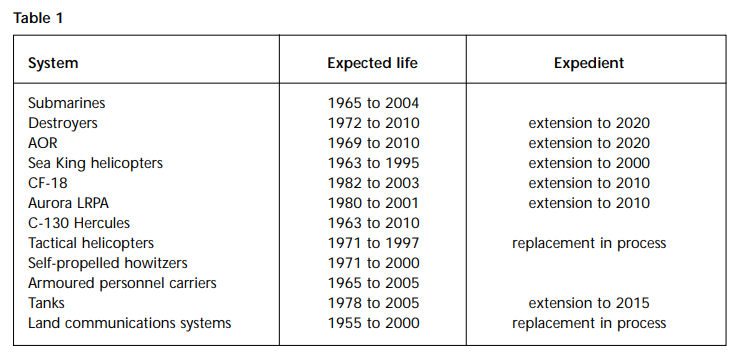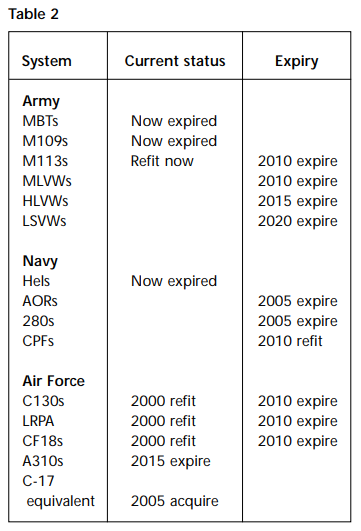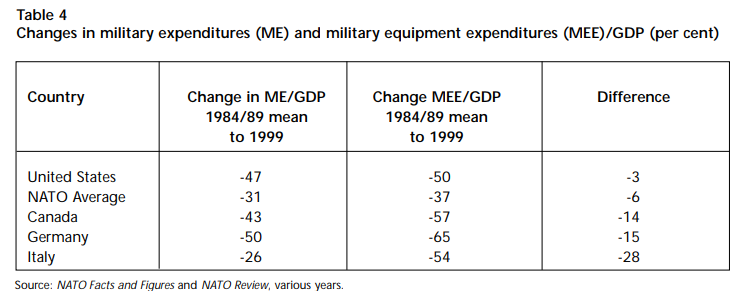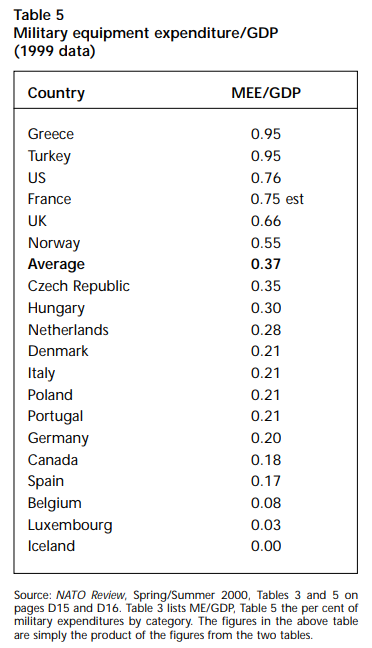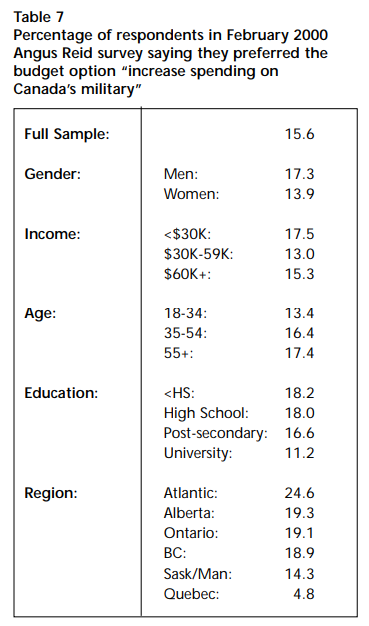
The easy answer to the question posed in the title of this article is “No.” The difficult part is figuring out why not, and whether there is any way to change it. Two factors affect the position of the Canadian Forces: technology and strategy that are rapidly evolving, and not enough money.
The financial dilemma is driven by the “rust-out” of the large number of major platforms, which have already reached their “pull-by date,” or will reach them during the period of the Strategy 2020 planning document. As things stand now, future foreign policy will be determined by budgetary decisions forced on the Canadian Forces about what equipment will not be replaced. The alternative model, that of “shaving the ice cube” by incremental reductions, simply cannot cope with the decaying equipment, except through ruinous increases in maintenance costs—as the sorry spectacle of the Sea King helicopters demonstrates daily.
Technology and modern business practices are taking their toll on the Forces, too. Tactics like “just-in-time delivery” and “just-in-time manufacturing” create a technology cycle that is so short compared with the long military procurement/service life cycle that components used in major equipment often cease to be available partway through the service life of that equipment.
The strategic factor is evolving just as fast and is driving changes in organizational design in the United States. The army, for example, envisions medium divisions built around a medium armoured vehicle family that are capable of being deployed anywhere in the world within 96 hours. The US Air Force is reacting to the events of the Kosovo campaign with a new emphasis on munitions based on global positioning system/inertial navigation system (GPS/INS) in addition to laser-guided precision guided munitions (PGMs), which might have profound implications for the future of the fighter/ground attack aircraft concept.
NATO, in its Defence Capabilities Initiative, wants better co-operation among the forces of member states, and increased NATO military capabilities. In a recent edition of NATO Review, Dr. Elinor Sloan described those capabilities as “deployability and mobility of allied forces, their sustainability and logistics, their survivability, their effective engagement capability, and their command and control and information systems.” One effect of the Defence Capabilities Initiative on Canadian policy has been a thrust to add strategic airlift and sealift capabilities, which, up to now, have not been part of the Canadian capabilities matrix. While it’s a justifiable strategy, it exacerbates our financial problem.
Finally—another burden on the Canadian Forces—there seems to be relatively little public support for spending on military equipment.
In its 1994 report, the Special Joint Committee of the Senate and House of Commons on Canada’s Defence Policy identified rust-out points for major equipment as indicated in Table 1. Their analysis was presumably based on a set of standard life expectancy modelling assumptions such as:
Ship hulls/propulsion 40 years
Airframes 30 years
Armoured vehicles 30 years
Soft-skinned vehicles 20 years
These figures presume a refit at the half-life point in order to upgrade capabilities in line with current technology, and perhaps to deal with obsolete computer chips and other electronics components that simply aren’t available any more. But we tend to delay the refit to about the two-thirds point, and American defence figures suggest a limit of 35 years in a ship’s service, five fewer than the Canadian specification. We might thus modify the Special Joint Committee’s table to calculate the expiry dates shown in Table 2 for these and other platforms, which collectively suggest a mass Canadian Forces extinction date of around 2010-2015.
The driver of military technological innovation is increasingly found not in the military but in the civilian R&D environment. In particular, the information and communications technology sector has a short turnover cycle—very much shorter than the traditional military procurement cycle. Moreover, the ability of individual states to keep up technologically varies greatly and depends on the strength of R&D investment in the states themselves. The just-published OECD study titled Measuring the ICT Sector 2000 provides a ranking of NATO states on the basis of their percentage share of world R&D in information and communications technology (see Table 3). This complete US dominance in civilian ICT R&D that it testifies to is paralleled in military R&D. The United Nations Institute for Disarmament quotes the Bonn International Centre for Conversion to the effect that “the United States is by far the largest spender on military R&D in the world, accounting for almost two thirds of the global total.” This finding is similar to the comment of the Chairman of Lockheed Martin in a recent address to the Atlantic Council of the United States: “R&D expenditures in the United States [were] exceeding those in all of Europe combined by a factor of approximately 3-to-1 annually.” These figures suggest that the US accounts for about 75 per cent of total NATO military R&D.
For its part, the US Department of Defence has reported to the President and Congress that the country’s total expenditures on military “research, development, testing, and evaluation (RDT&E),” amounted to $106.5 billion from 1995-97. That’s about the same as total military equipment spending of the rest of NATO for the same period (based on data published in The NATO Review and World Military Expenditures and Arms Transfers 1998).
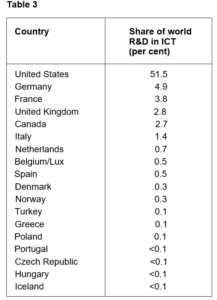 The staggering US investment in R&D, both civilian and military, indicates that there will be continuing pressure on the other NATO states to maintain “inter-operability”—that is equipment compatibility—with the US an increasingly expensive business.
The staggering US investment in R&D, both civilian and military, indicates that there will be continuing pressure on the other NATO states to maintain “inter-operability”—that is equipment compatibility—with the US an increasingly expensive business.
Laser-guided PGMs (precision-guided munitions) were the “technological leap” stars of the Persian Gulf War, relegating “dumb” gravity bombs to the category of obsolete weaponry. Nonetheless, by the opening of the Kosovo campaign some 10 years later, only a limited number of NATO air forces had actually made the same “technological leap.” Those who had discovered that the difficult weather conditions and the political dictum that aircraft had to fly above the range of Serb anti-aircraft artillery rendered them less effective than had been the case in the flat terrain and more favourable weather conditions of the Persian Gulf campaign.
The “technological stars” of the Kosovo campaign represented a leap beyond PGM technology, involving the use of global positioning system/inertial navigation system (GPS/INS) guidance. The air-delivered gravity bombs were fitted with a simple add-on tail kit with a GPS position locator, a simple on-board computer and controllable fins, which provided the bomb with an “intelligence kit” able to tell it where it was and where it was supposed to go, and to provide the means to re-vector its flight path accordingly. Similar technologies are being added to the various US Army and Navy platforms. The accuracy of the basic GPS/INS system is expressed as a “circular error probable” (CEP) of 13 metres.
An improved version with a projected CEP accuracy of just three metres makes use of the Direct Attack Munitions Affordable Seeker (Damask). Damask is an add-on imaging infrared (IIR) focal plane-array seeker.
As Jane’s Defence Weekly reports: “Most focal-plane arrays require cooling, but with the Raytheon-developed IIR system borrowed from the Cadillac (automobile) range, which allows a driver to see beyond the car’s headlights, this is not necessary. Damask’s IIR module views imagery through a low-cost lens on the front of the bomb/missile/shell and is integrated into the JDAM GPS/INS guidance system using specially developed software.” An image of the target area is stored inside the Damask processor. This template can be created from an aerial photograph, synthetic aperture radar or satellite imagery. After release, the weapon uses its GPS/INS system guidance, but at about 1,600 metres from the target, Damask switches on and compares the view through its seeker with the stored template. “At 1,100 metres a correction manoeuvre kicks in to bring the weapon precisely on to the target,” Jane’s says.
The implications of such technological leaps can be grasped by imagining how weapons from earlier times might have been updated for use in recent conflicts like Kosovo. Ian Hogg recounts in Twentieth Century Artillery that in World War I, “Sceneshifter” and “Piecemaker,” two British railway guns of 343 mm (13.5 in) calibre, fired a shell of 567 kg (1,250 lb) a distance of 36.6 km. Imagine updating these two guns with rocket-assist projectiles (RAP) to extend their range to 175 km, with GPS/INS Damask final guidance with a three-metre CEP, plus a full set of modern projectiles—and then deploying them in the Kosovo campaign, on the coastal railway line in Albania at Skodra, opposite Kosovo, and providing them with observers in Kosovo, equipped with their own GPS position locators, and laser rangefinders like those used by the Canadian Forces today, and a cell phone.
With observers able to identify a target for the two guns, the response time, assuming that they were already loaded, would be essentially that of the time of flight from gun to target. Since the two railway guns are indifferent to weather or time of day, they could engage whatever the observers could see and on a completely continuous basis—something not always possible with munitions delivered by air.
Now let’s consider whether aircraft would be in any way a cost-effective competitor to the two railway guns and what that would mean to the military organization. The two “obsolete” railway guns would not be dependent on airborne tankers to refuel in their long run down from the Aviano airbase, nor on the availability of an escort to protect the tankers during refuelling. How many expensive CF-18 aircraft would we need to keep in inventory if their role were eroded by a more cost-effective technology? How many fewer pilots might we need, and how many might we need to train annually? How many training bases would we need to keep in the face of reduced pilot training requirements, and how many maintenance and logistics personnel? What ultimately would be the proportionate shares of national personnel, operations and management and capital equipment budgets?
Such are the questions raised by a single look at the possible military implications of applying a civilian technology to a pair of “obsolete” WWI railway guns on the modern battlefield. The lesson here is that we are guaranteed to have great difficulty in the future with the “systems” impact of intensely rapid technological change. Such change can drive tactical employment in directions that are beyond the coping ability of existing military structures, and which will require extraordinarily expensive reorganization and re-equipping.
The rush to downsize military expenditures is not restricted to Canada. Within the NATO alliance, cuts to capital renewal have been much deeper than to personnel, operations, and maintenance expenditures—for it is politically easier to cut a contract that has not been awarded than to close a military base that is critical to the health of a local economy.
A favourite statistic for cross-country comparisons in “burden sharing” analysis, is the proportion of Gross Domestic Product devoted to defense (or military) expenditures (ME/GDP). A useful though infrequently used parallel statistic can also be calculated: the proportion of GDP devoted to military equipment purchases (MEE/GDP). If we compare the average figures for the 1984/89 period, just before the Cold War ended, to those of 1999, 10 years after its end, we note that ME/GDP for the 13 NATO states for which we also have MEE/GDP statistics (all but France, Spain, the Czech Republic, Hungary and Poland) declined, on average, by 31 per cent—from 3.1 per cent of GDP to 2.1 per cent. However, the average MEE/GDP declined even more—by 37 per cent, from 0.59 per cent to 0.37 per cent of GDP. In some cases the decline was effectively the same for both figures. In other cases their movement was sharply divergent, as Table 4 indicates.
The use of the MEE/GDP figure also produces a set of cross-country groupings within the alliance (see Table 5). The question that falls out of this table is whether the NATO Defence Capabilities Initiative goal of inter-operability with the US can be achieved without an approximate match of the United States’ MEE/GDP—or, indeed, whether effective technological disarmament can be avoided without raising MEE/GDP to near the United States range. Meanwhile, we must bear in mind that the General Accounting Office of the United States Congress, as well as a large number of analysts both in and out of government, have argued that the current level of American capital procurement is itself inadequate to maintain the capabilities that the US currently possesses.
What is also interesting is the emergence of the group of seven countries, including four of the seven largest economies in the alliance, which seem to be converging on an MEE/GDP of 0.20—which seems to constitute a de facto adoption of a policy of technological disarmament. If the objectives of the Defence Capabilities Initiative are to be met, it seems obvious that those states in particular will have to increase MEE/GDP—either through increased defence funding by their national governments or by severe cuts to their personnel, and operations and maintenance budgets and the subsequent transfer of those funds to the capital side. The table suggests that a better than doubling of the MEE budgets would be required, and a trebling might not be out of the question. The ability of the Canadian defence budget, in particular, to generate such reinvestment levels seems remote, unfortunately.
The 2000 Report of the Auditor-General of Canada makes dreary reading in terms of the need for recapitalization of the Canadian Forces. It includes such comments as:
In 1998 we audited the capital equipment program of National Defence, which accounts for spending of $1.4 billion a year. We assessed how well the Department was maintaining the modern, multi-purpose forces required by the government’s policy. According to departmental business plans, the Department would require $11 billion in capital funds over the next five years but would receive only $6.5 billion, resulting in a $4.5 billion shortage … (Chapter 16, para. 111)
A review of the Department’s budgetary situation concluded in November 1999 that the Department had lost all flexibility to cope with cumulative resource pressures and was “out of manoeuvring room.” Defence planners estimated that the Department would require over $1 billion annually in additional funding to operate even a smaller force while modernizing, revitalizing infrastructure and maintaining readiness (para. 125).
And if the increases announced in the 2000 budget made up a portion of the shortfall, “officials estimate that each year the Department is still about $750 million short of the amount needed to modernize and maintain readiness” (para. 116).
This 2000 increase in the defence budget provides for around $11.2 billion in constant dollar terms. Since the primary influence upon Canadian ME/GDP appears to be future expectations of changes in the United States ME/GDP, one might forecast, in the absence of any clear move to massively increase US ME/GDP, that the Canadian defence effort will remain at about $11.2 billion in constant dollars to the end of the Strategy 2020 period. With the promise to work up to 23 per cent for the capital account, that implies a gradual move to a capital budget of $2.6 billion in real terms, or $52 billion over the 20-year period covered by Strategy 2020. Characteristically, however, the capital account devotes about one quarter of its total to bricks and mortar, and minor capital procurement, so that the best that can be expected for major equipment purchases is about $1.9 billion per year.
Since future foreign policy options are written by current capital procurement, we are left with the awkward question of how much military capability can be bought for a capital procurement budget of $1.9 billion per year, or $38 billion over the 20-year period. It certainly isn’t enough to simply maintain what we have. If the Auditor-General is correct, the shortfall over the period to 2020 is about $15 billion in the capital budget—and we expect that the Auditor-General is an optimist, particularly if we are to respond to the need to increase capital spending in order to stay even remotely in sight of the American technological bow wave.
So the really interesting question is: “Which capabilities are we going to be forced to abandon?” Will we have a coherent plan for such abandonment, or will we continue with such “shaving the ice cube” expedients as seem to be in the works for the air force—like the decision not to upgrade 42 of the 122 CF-18s, two of the 18 Auroras, and the three Arcturus Long Range patrol aircraft.
Another interesting aspect of the defence budget lies in the percentage shares devoted to the four major categories reported in the NATO statistics of equipment, personnel, operations and maintenance, and infrastructure. Table 6, taken from various editions of NATO Facts and Figures, displays quite clearly the difference between the “rust-out” period of the 1970s and the potential “rust-out” period of the late 1990s/2000s. In the first, equipment spending was crowded out by personnel spending, as the Forces attempted to maintain their human resources at the expense of recapitalization. The contemporary period is quite different—both equipment spending and personnel spending are being crowded by substantial increases in operating expenses, and to a lesser degree by infrastructure spending. Curiously, the Auditor-General has reported that operating expenditures do not vary significantly with the level of operations of the Canadian Forces, which suggests that the real problem lies with “fixed” operating costs, which are incurred regardless of the intensity of the activity level of the Forces.
This brings us to the troubling question of how we are going to convince the Canadian public to foot the bill for recapitalization. A February 1998 poll done by Angus Reid for the Globe and Mail asked those surveyed to choose between two alternatives, and found that public support for increased capital spending on defence equipment lost to every other alternative offered. The split ran from 92 per cent to seven per cent against “jobs for young people,” and 91 per cent to seven per cent against “child care benefits,” to 49 per cent to 44 per cent against “film production.”
A similar poll conducted by Angus Reid in February 2000 posed the question, “If you had responsibility for spending the federal government’s $95 billion surplus over the next five years, which of the following would be your Guns and butter main priority?” It found that the option, “Increase spending on Canada’s military,” finished dead last, with just 15.6 per cent of respondents favouring it over all other options offered, including increased spending on arts and culture.
This second poll also provided a demographic breakdown of the results. Table 7 shows the percentage of respondents in various groups who did prefer “increased spending on Canada’s military.” One of the most striking results is that support for defence spending decreases as education levels rise—which is not entirely difficult to understand given the almost complete absence of the military from university campuses since the elimination of the UNTD (University Naval Training Division) and COTC (Canadian Officer Training Corps) programs in the late 1960s. Given that the university-educated form the basis of the civilian managerial elites who govern the country, the absence of broad support within the federal government for increases in defence spending makes sense. When a significant portion of the country’s governing coalition comes from the province of Quebec, which has an overwhelming preference for any priority other than defence spending, increased allocations for military procurement seem even more unlikely.
Given the normal lag between the decision to replace a platform and the actual point of “cutting metal,” a lag that is driven by the bureaucratic nature of the procurement process, it seems obvious that the current government will, quite literally, determine whether the Canadian Forces live or die—for there are simply too many major platforms hitting their “pull-by dates” in the 2010-2015 time frame. One can only hope that there will be a rational basis for that determination.
Photo: Shutterstock




